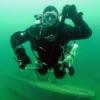I have been told to count on around 20 pounds for a flooded loop on my unit. I don't know about a good number to count on for the drysuit. It depends on the fit (custom versus stock) and the thermal undergarments. It would be nice to have a good fudge factor number for that.So, if you are wearing additional lead to overcome the positive buoyancy of the gas spaces, and those spaces go bye-bye, you are now very overweighted. That's the problem.
Can you define "very overweighted"? When you flood your loop, you are flooding a defined volume of space and we can certainly give a weight to that volume of water. Can we do the same with the displaced trapped air held in by a drysuit? Is it 10#, 30#, 100#???

BC/Wing lift capacity
#31

Posted 27 July 2006 - 10:23 AM
"For the diligent diver, closed circuit rebreathers are actually safer than open circuit scuba." Tom Mount
#32

Posted 27 July 2006 - 10:27 AM
And if it were me, I'd fully test a flooded loop on that unit. I know we will do that up here...
#33

Posted 27 July 2006 - 10:29 AM
It wasn't fully flooded. However, we were required to flood and clear the loop in our class. Take out of mouth with the DSV (mouthpiece open), count to ten, clear.Yea, that's what I was thinking. A ballpark figure to count on would be very helpful.
And if it were me, I'd fully test a flooded loop on that unit. I know we will do that up here...
"For the diligent diver, closed circuit rebreathers are actually safer than open circuit scuba." Tom Mount
#34

Posted 27 July 2006 - 10:40 AM
#35

Posted 27 July 2006 - 10:43 AM
I was okay with doing it in fresh water. I would not want to expose my oxygen sensors to this in salt water.Yea, I can't WAIT to do that in class.... NOT!
"For the diligent diver, closed circuit rebreathers are actually safer than open circuit scuba." Tom Mount
#36

Posted 27 July 2006 - 10:52 AM
Great explanation Howard. When I flooded, I simply got cold - REALLY cold on the dive. In the event of my flood, my neckseal peeled off the suit - in other words a major opening, not some little tear. I dove in a bit of a head down position and was still able to gurgle air into the suit. The real difficulty came when I was climbing out of the water with doubles on and a full suit - I mean FULL. The lower half of my suit looked like the Michelin Man. I had to have it pulled off of me by a buddy and dumped. That sucked.A flooded suit does not make you negative since the salt water itself is not doing anymore to you than it would if you were swimming in a bathing suit. However, since the undergarments worn trap some gas, creating a space of it between the body and the suit, which is in direct contact with the water, flooding the suit fills those spaces with water, removing that gas, and taking away any positive buoyancy that the gas spaces created. So, if you are wearing additional lead to overcome the positive buoyancy of the gas spaces, and those spaces go bye-bye, you are now very overweighted. That's the problem.In my case, I now dive with either a 45# or 60# wing. I know that I am approximately 10-15# negative in the water in my doubles. Does a flooded suit exceed the 30-45# extra buoyancy I might be carrying?
The remedies are simple (at least in theory). 1) Carry weight that can be ditched in case of a flooded suit. Then, the diver will not be overweighted. 2) Carry a wing that can offset the negative buoyancy of what can not be ditched by the diver. 3) Combinations of the first two.
Of course, when the diver gets to the surface and then tries to climb out of the water, for every cubic foot of water in the suit, that adds another 64 pounds (based on salt water) of weight that the diver must lift out. Remedy? Simple: get dive boats to start using those diver lifts (instead of ladders) like they do in Europe and other parts of the world.
Once in a while, it is good to step back, take a breath, and remember to be humble. You'll never know it all - ScubaDadMiami. If you aren't afraid of dying, there is nothing you can't achieve - Lao-tzu. One dog barks at something, the rest bark at him - Chinese Proverb.
#37

Posted 27 July 2006 - 11:11 AM
Of course, when the diver gets to the surface and then tries to climb out of the water, for every cubic foot of water in the suit, that adds another 64 pounds (based on salt water) of weight that the diver must lift out. Remedy? Simple: get dive boats to start using those diver lifts (instead of ladders) like they do in Europe and other parts of the world.
Nice dream. I can't see them fitting a lift on some of the six packs that I dive off of. Most of those six-packs don't carry a DM to help you up the ladder either. The only crew is the captain and the passengers lend a hand where they can. There are methods to make that easier though. In the event of a heavily flooded drysuit, ask and ye shall receive from the rest of us in helping you onto the boat.
I would hate to have been DG trying to climb up the ladder in that suit. To the sheer weight of the water add on that she was likely cold as ice and that was sapping strength as well. That is yet another reason that I prefer to take off and put on my deco bottles in the water. I prefer to not be hiking around boat decks without the added weight of my deco bottles. The first that I had seen divers put on their deco bottles on prior to entry was in NC over the fourth. Most of my buddies have the captain/crew/other passengers hand them the bottles after they go into the water or hang them from an equipment line.
#38

Posted 27 July 2006 - 11:28 AM
It wasn't a deco dive and I was luckily shore diving. I crawled up the sandy beach to the steps which looked 100' high at that point!I would hate to have been DG trying to climb up the ladder in that suit. To the sheer weight of the water add on that she was likely cold as ice and that was sapping strength as well. That is yet another reason that I prefer to take off and put on my deco bottles in the water. I prefer to not be hiking around boat decks without the added weight of my deco bottles. The first that I had seen divers put on their deco bottles on prior to entry was in NC over the fourth. Most of my buddies have the captain/crew/other passengers hand them the bottles after they go into the water or hang them from an equipment line.
I also have deco bottles handed to me and clip off or set down at the end of the dive, no walk outs or ladder climbs with them.
Once in a while, it is good to step back, take a breath, and remember to be humble. You'll never know it all - ScubaDadMiami. If you aren't afraid of dying, there is nothing you can't achieve - Lao-tzu. One dog barks at something, the rest bark at him - Chinese Proverb.
#39

Posted 27 July 2006 - 05:59 PM
I have no experience diving dry, but I can imagine that once a drysuit is flooded, the inertia of the water inside your suit vastly limits mobility, even after you re-establish buoyancy with your BC. Kind of like trying to swim wearing a full set of street clothes and a goose down coat. That will tire you out real fast; not a situation where you want to frantically be trying to maneuver or do a lot of hard finning. I'm curious what the dry divers who have flooded thought about that part of the experience?
When you make fish laugh, they can't bite you.
#40

Posted 27 July 2006 - 09:52 PM
My wing will just float me at the surface when full and yet I get enough lift at depth.
~ Trace
Technical Training Director
PDIC International
#41

Posted 27 July 2006 - 10:22 PM
Thanks for your comments. I have a question for you. I asked the same of Geek, but he seems to have disappeared.
What kind of runtimes are you getting on those ocean dives?
I have a great deal of trouble imagining myself running out of gas with 2 AL80s on my back, and AL80 stage, and a 40cuft bottle of 50/50 in an hour. That's 240cuft of backgas. And it would make me less than 15# negative. Aluminum backplate (2#), 4hr can light (2.5#), and I'm still less than 20 pounds negative.
Why are you guys taking huge steel cylinders in the ocean? Do you really need 350+ cuft of gas for what you're doing?
#42

Posted 27 July 2006 - 11:48 PM
If I dove Al80s as doubbles I'd have to add weight somewhere.With 2x130s=260cuft of gas so where your diving doubbles plus 80 plus a 40 I'm using doubles and a 40.
Currently with 200psi in my 130s (crushed neoprene suit,fleece,1/4" S/S BP,a canister light(SLA)) and empty wing with no suit squeeze I can do controlled accents in 3FT steps of 30sec to the surface.I then adjust weight depending on stages/deco bottles.
A common practice for our group is to do a couple dives on one set of doubbles(bringing a fresh 40 for each dive) and then use whats left for doing skills 'n' drills in the shallows rather than blow off the gas.
As to run times,well we don't always utilize all the gas(leaving a safe reserve) on each dive but from a practial point(to us) diving a consistant set up makes more sense and one set of doubbles easier then bringing a couple smaller sets(less space,less weight,less wasted gas).THat being said I also have a set of twin 72s that I'll use in a similar config as you do with the twin 80s,80 stage and 40 deco.
This is not a representation of the PNW but seems to work for the type of diving we do but most that ever dove twin AL80 no longer do so but I'm sure there are those doing so around here.
#43

Posted 28 July 2006 - 12:01 AM
Trace,
Thanks for your comments. I have a question for you. I asked the same of Geek, but he seems to have disappeared.
What kind of runtimes are you getting on those ocean dives?
I have a great deal of trouble imagining myself running out of gas with 2 AL80s on my back, and AL80 stage, and a 40cuft bottle of 50/50 in an hour. That's 240cuft of backgas. And it would make me less than 15# negative. Aluminum backplate (2#), 4hr can light (2.5#), and I'm still less than 20 pounds negative.
Why are you guys taking huge steel cylinders in the ocean? Do you really need 350+ cuft of gas for what you're doing?
I can't speak to the ocean divers, but I can speak for the Great Lakes dives that I do. I am looking at 60-70 minute runtimes. The dive that I am planning for next weekend involves 185 ft. depth with contiguency for 200 ft. and 25-30 minute bottom time. Figure a working RMV of .7 cubic ft/min and multiply by 1.5 to accomdate rule of thirds. That is a whole lot of gas required. That is what I have to concern myself with. I take either 200 cubic ft. or 260 cubic ft. of tri-mix with me.
The oxygen bottle is useless below 20 ft. unless I want to invite CNS toxicity. Depending on how deep that I am diving, the intermediate deco gas is not wise to use below 70 ft. or 110 ft. and my first deco stop is often at 60-90 ft.
On these dives, I could do the deco on one gas. I choose not to for one reason. If I can't access my deco gas, I will not have adequate backgas to do my decompression (especially considering that it is tri-mix). I will have enough of either deco gas to do my complete deco on that alone if I have a failure occur. Two deco gases will get me out of the water more quickly.
PS I am pulling dive plans that I figured out when I did my Normoxic course. I am looking at dive plans that call for anywhere from 220 to 175 cubic ft. of backgas. These are dives to between 150-190 ft. with written plans. Where I vary from the previous post is that I prefer one deep, long dive per day. I don't squeeze two dives out of a set of doubles unless I am doing "recreational" or "extremely light deco" profiles. So, I like to plan for maximum bottom time/deco profiles.
#44

Posted 28 July 2006 - 12:29 AM
A couple of questions if I may...
1. Why are you diving thirds in the great lakes? It would seem that you could easily get away with halves unless you are penetrating wrecks. Maybe you are.
2. You are taking 200-260cuft of gas. My Double 80s with a stage is 240cuft (well closer to 230, but still). It's close
3. You are doing 2 gas switches. I guess if I had 200ft dives planned, I would too. Right now, I am going to be looking at 150ft dives max for a while.
4. You don't carry enough backgas to deco on it? Seems that lost gas planning would dictate it, unless you plan on buddy breathing with your buddy on the stops. If you lose the 50% bottle, you're not just going to blow off everything until you get to 20ft are you?
Thanks for your response.
#45

Posted 28 July 2006 - 12:38 AM
I suspect that Trace is using two deco gases...
If I dove Al80s as doubbles I'd have to add weight somewhere.With 2x130s=260cuft of gas so where your diving doubbles plus 80 plus a 40 I'm using doubles and a 40.
Currently with 200psi in my 130s (crushed neoprene suit,fleece,1/4" S/S BP,a canister light(SLA)) and empty wing with no suit squeeze I can do controlled accents in 3FT steps of 30sec to the surface.I then adjust weight depending on stages/deco bottles.
A common practice for our group is to do a couple dives on one set of doubbles(bringing a fresh 40 for each dive) and then use whats left for doing skills 'n' drills in the shallows rather than blow off the gas.
As to run times,well we don't always utilize all the gas(leaving a safe reserve) on each dive but from a practial point(to us) diving a consistant set up makes more sense and one set of doubbles easier then bringing a couple smaller sets(less space,less weight,less wasted gas).THat being said I also have a set of twin 72s that I'll use in a similar config as you do with the twin 80s,80 stage and 40 deco.
This is not a representation of the PNW but seems to work for the type of diving we do but most that ever dove twin AL80 no longer do so but I'm sure there are those doing so around here.
I guess what I am seeing is that you guys in the ocean (or with very deep bottoms) are not wearing weightbelts. I think for me, I'd prefer to wear the AL tanks and a small weightbelt. Ditching the belt in the event of a flood would bring me back to neutral or nearly so. And then I could work from there. Here in the springs I am diving wet, AL80 doubles, no can light for now, and don't wear any weigth. If I lost the wing, I could literally crawl out of any of the places I dive. Or shoot a bag.
With a non-reachable bottom below me (either because of depth or MOD) I'd prefer a way to get neutral or positive by ditching weight. If I was wearing 108s, or 130s, or God forbid 104s, I would be in a very difficult position I think.
I do agree that bringing one set of doubles is easier. But I think I'd rather deal with the inconvenience than deal with the potential hazards.
This has been a very informative thread. Thank you all.
0 user(s) are reading this topic
0 members, 0 guests, 0 anonymous users

















